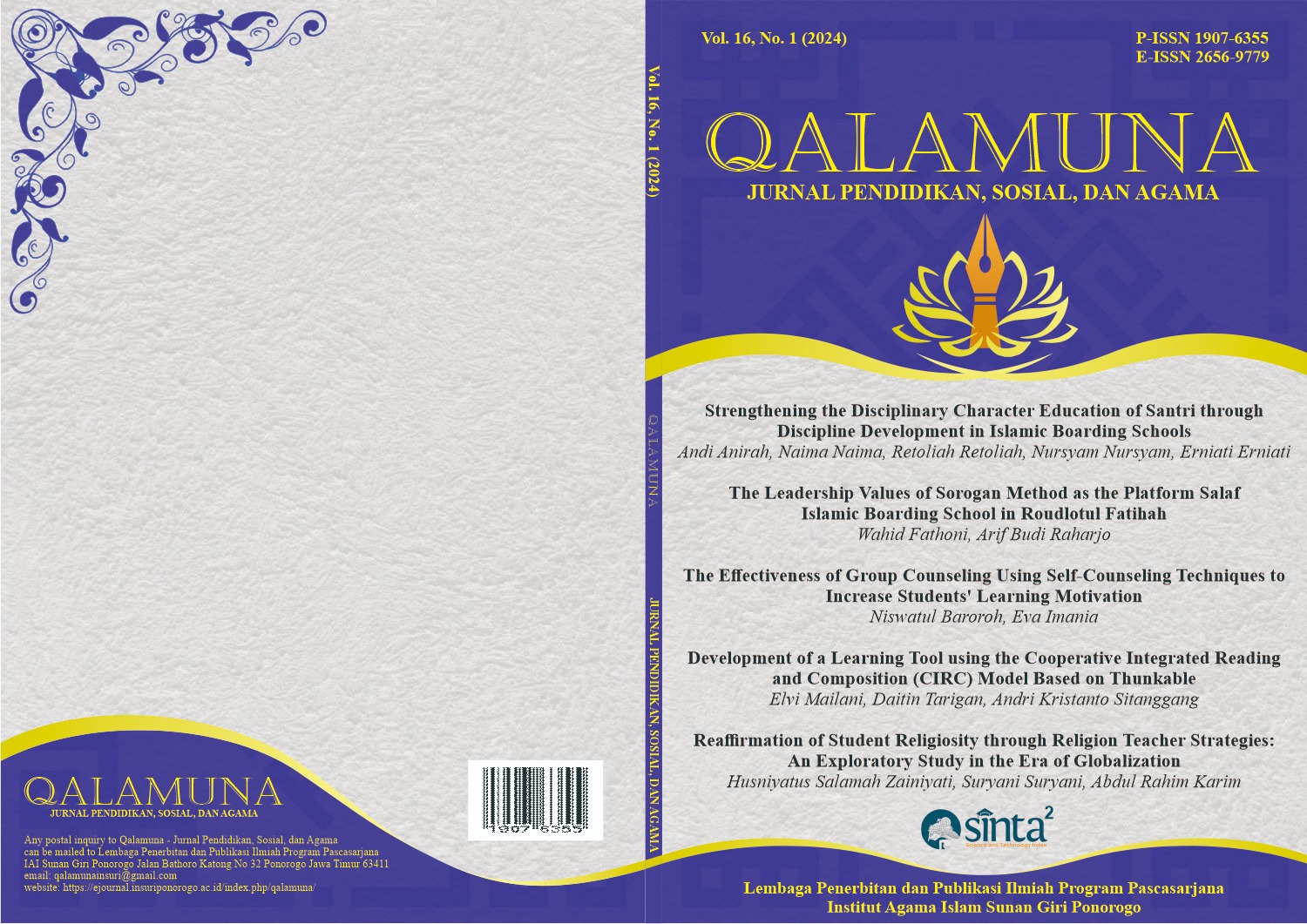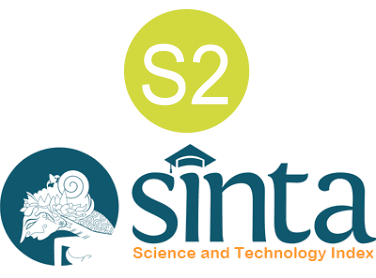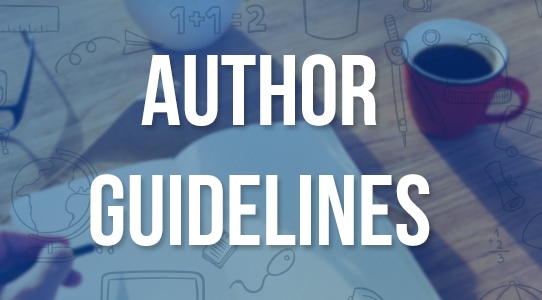Mathematics Teachers’ Design of Numeracy Task in Geometry and Measurement Content
DOI:
https://doi.org/10.37680/qalamuna.v16i1.4865Keywords:
numeracy, task design, geometryAbstract
Geometry and measurement affect our daily lives, both personal and sociocultural. Geometry is one of the contents in numeracy taught at every level of education. This study aimed to determine mathematics teachers' design of numeracy tasks using geometry and measurement content. Ninety-three math problems were collected from mathematics teachers in 31 Padang Pariaman districts, West Sumatra, Indonesia. Teachers were given problem-posing tasks and then asked to design numeracy tasks. To analyze, the tasks were classified as solvable or unsolvable and then further divided into context use level and cognitive process level domains. The numeracy context (personal, sociocultural, and scientific) was also analyzed. The study found that the tasks created had varying levels of context utilization, ranging from zero to second-order context. Most of the activities proposed were at the comprehension level, with just a tiny number designated as thinking functions in terms of cognitive processes. Some teachers' draft numeracy tasks in geometry content are discussed further.
References
Ahyan, S., Zulkardi, & Darmawijoyo. (2014). Developing mathematics problems based on Pisa's level of change and relationship content. Journal on Mathematics Education, 5(1), 47–56. https://doi.org/10.22342/jme.5.1.1448.47-56
Anderson, L. W., Krathwohl, D. R., & Bloom, B. S. (2000). A Taxonomy for Learning, Teaching, and Assessing: A Revision of Bloom’s Taxonomy of Educational Objectives. https://api.semanticscholar.org/CorpusID:61966728
Annisavitri, R., Sa’Dijah, C., Qohar, A., Sa’Diyah, M., & Anwar, L. (2020). Analysis of mathematical literacy test as a problem-solving ability assessment of junior high school students. AIP Conference Proceedings, 2215(April). https://doi.org/10.1063/5.0000648
Baron, L. M. (2015). Financial Literacy with Families: Opportunity and Hope. Journal of Urban Mathematics Education, 8(1). https://doi.org/10.21423/jume-v8i1a258
Barwell, R., Clarkson, P., Halai, A., Kazima, M., Moschkovich, J., Planas, N., Setati Phakeng, M., Valero, P., & Villavicencio Ubillús, M. (2016). Introduction: An ICMI Study on Language Diversity in Mathematics Education. In New ICMI Study Series. https://doi.org/10.1007/978-3-319-14511-2_1
Beswick, K., Swabey, K., & Andrew, R. (2008). Looking for attributes of powerful teaching for numeracy in Tasmanian K-7 classrooms. Mathematics Education Research Journal, 20(1), 3–31. https://doi.org/10.1007/BF03217467
Cohen, P., Cuban, L., Ellis, W. J., Ewell, P., Hallett, D., & Kennedy, D. (2001). Mathematics and Democracy.
Creswell. (2015). Creswell, J.W. (2015). Penelitian Kualitatif & Desain Riset Memilih Diatara Lima Pendekatan (Edisi Ke-3). Yogyakarta Pustaka Pelajar. 2015.
Elia, I., van den Heuvel-Panhuizen, M., & Gagatsis, A. (2018). Geometry Learning in the Early Years: Developing Understanding of Shapes and Space with a Focus on Visualization. In V. Kinnear, M. Y. Lai, & T. Muir (Eds.), Forging Connections in Early Mathematics Teaching and Learning (pp. 73–95). Springer Singapore. https://doi.org/10.1007/978-981-10-7153-9_5
Geiger, V., Forgasz, H., & Goos, M. (2015). A critical orientation to numeracy across the curriculum. ZDM - International Journal on Mathematics Education, 47(4), 611–624. https://doi.org/10.1007/s11858-014-0648-1
Geiger, V., Goos, M., & Dole, S. (2014). Curriculum Intent, Teacher Professional Development and Student Learning in Numeracy BT - Mathematics Curriculum in School Education (Y. Li & G. Lappan (Eds.); pp. 473–492). Springer Netherlands. https://doi.org/10.1007/978-94-007-7560-2_22
Genlott, A. A., & Grönlund, Å. (2016). Closing the gaps - Improving literacy and mathematics by ict-enhanced collaboration. Computers and Education, 99, 68–80. https://doi.org/10.1016/j.compedu.2016.04.004
Ginsburg, L., Manly, M., & Schmitt, M. (2006). The Components of Numeracy. National Center for the Study of Adult …,. December. https://www.researchgate.net/publication/267565484
Goos, M., Dole, S., & Geiger, V. (2011). Improving numeracy education in rural schools: A professional development approach. Mathematics Education Research Journal, 23(2), 129–148. https://doi.org/10.1007/s13394-011-0008-1
Goos, M., Geiger, V., & Dole, S. (2012). <p>Auditing the numeracy demands of the middle years curriculum</p>. PNA. Revista de Investigación En Didáctica de La Matemática, 6(4), 147–158. https://doi.org/10.30827/pna.v6i4.6138
Goos, M., Geiger, V., & Dole, S. (2013). Designing Rich Numeracy Tasks. Task Design in Mathematics Education, 1, 589–597.
Hartati, M., Ario, F., Nurhafni, Imayanti, R., & Andrian, Y. (2020). Panduan Gerakan literasi Sekolah di SMA Tahun 2020. Kemendikbud, 1, 1–64.
Hoogland, K. (2023). The changing nature of basic skills in numeracy. Frontiers in education, 8. https://doi.org/10.3389/feduc.2023.1293754
Katrina, Crotts. (2014). Assessing Quantitative Literacy in Higher Education: An Overview of Existing Research and Assessments With Recommendations for Next-Generation Assessment. In Handbook of test development (Vol. 34, Issue 2). https://doi.org/10.1002/ets2.12024
Kemendikbud. (2020a). AKM dan implikasinya pada pembelajaran. Pusat Asesmen Dan Pembelajaran Badan Penelitian Dan Pengembangan Dan Perbukuan Kementerian Pendidikan Dan KebudayaanPembelajaran Badan Penelitian Dan Pengembangan Dan Perbukuan Kementerian Pendidikan Dan Kebudayaan, 1–37.
Kemendikbud. (2020b). Desain Pengembangan Soal AKM [AKM Question Development Design]. Jakarta: Kementrian Pendidikan Dan Kebudayaan, Pengembangan Dan Perbukuan.
Kieran, C., Doorman, M., & Ohtani, M. (2015). Frameworks and Principles for Task Design BT - Task Design In Mathematics Education: an ICMI study 22 (A. Watson & M. Ohtani (Eds.); pp. 19–81). Springer International Publishing. https://doi.org/10.1007/978-3-319-09629-2_2
Kolar, V. M., & Hodnik, T. (2021). Mathematical literacy from the perspective of solving contextual problems. European Journal of Educational Research, 10(1), 467–483. https://doi.org/10.12973/EU-JER.10.1.467
Kwek, M. L. (2015). Using Problem Posing as a Formative Assessment Tool BT - Mathematical Problem Posing: From Research to Effective Practice (F. M. Singer, N. F. Ellerton, & J. Cai (Eds.); pp. 273–292). Springer, New York. https://doi.org/10.1007/978-1-4614-6258-3_13
Lee, K.-H., Lee, E.-J., & Park, M.-S. (2016). Task Modification and Knowledge Utilization by Korean Prospective Mathematics Teachers. Pedagogical Research, 1(2). https://doi.org/10.20897/lectito.201654
Lei, H., & Hu, A. (2020). Designing a Rich Numeracy Task in Early Childhood Mathematics Education: Teaching Addition in a Kindergarten in Macao. Studies in Social Science Research, 2(1), p1. https://doi.org/10.22158/sssr.v2n1p1
Liljedahl, P. (2015). Numeracy task design: a case of changing mathematics teaching practice. ZDM - International Journal on Mathematics Education, 47(4), 625–637. https://doi.org/10.1007/s11858-015-0703-6
Linuhung, N., Purwanto, Sukoriyanto, & Sudirman. (2023). How Students Solve Pizza Problems: An Exploration Of Students’ Mathematical Literacy. Angewandte Chemie International Edition, 6(11), 951–952., 12(November), 3573–3588. https://doi.org/AKSIOMA: Jurnal Program Studi Pendidikan Matematika Volume 12, No. 4, 2023, 357https://doi.org/10.24127/ajpm.v12i4.8997
Niswah, U., & Qohar, A. (2020). Mathematical Reasoning in Mathematics Learning on Pyramid Volume Concepts. Malikussaleh Journal of Mathematics Learning (MJML), 3(1), 23. https://doi.org/10.29103/mjml.v3i1.2400
OECD. (2017). PISA 2015 Mathematics Framework. OECD Publishing, 65–80.
Ojose, B. (2011). Mathematics Literacy: Are We Able To Put The Mathematics We Learn Into Everyday Use? https://api.semanticscholar.org/CorpusID:146305021
Ritter, S. M., Gu, X., Crijns, M., & Biekens, P. (2020). Fostering students’ creative thinking skills by means of a one-year creativity training program. PLoS ONE, 15(3), 1–18. https://doi.org/10.1371/journal.pone.0229773
Sa’dijah, C., Purnomo, H., Abdullah, A. H., Permadi, H., Anwar, L., Cahyowati, E. T. D., & Sa’diyah, M. (2023). Students’ Numeracy Skills in Solving Numeracy Tasks: Analysis of Students of Junior High Schools. AIP Conference Proceedings, 2569(January). https://doi.org/10.1063/5.0113664
Sahidin, L., & Sari, T. I. (2022). Analysis of Mathematical Literacy in Solving PISA Problems Based on Students’ Mathematical Ability. AL-ISHLAH: Jurnal Pendidikan, 14(4), 5347–5362. https://doi.org/10.35445/alishlah.v14i4.1789
Salgado, F. A. (2016). Developing a Theoretical Framework for Classifying Levels of Context Use for Mathematical Problems. Opening up Mathematics Education Research(Proceedings of the 39th Annual Conference of the Mathematics Education Research Group of Australasia), 1, 110–117.
She, H. C., Stacey, K., & Schmidt, W. H. (2018). Science and Mathematics Literacy: PISA for Better School Education. International Journal of Science and Mathematics Education, 16, 1–5. https://doi.org/10.1007/s10763-018-9911-1
Situmorang, G., Mulyono, B., & Susanti, E. (2023). Numeracy-Based Teaching Material with Data Presentation Topic to Support Students’ Numeracy Skills. Jurnal Matematika Kreatif-Inovatif, 14(2), 293–308.
Stacey, K. C., & Turner, R. (2015). The Evolution and Key Concepts of the PISA Mathematics Frameworks. https://api.semanticscholar.org/CorpusID:109886188
Steen, L. (2001). Mathematics and Numeracy: Two Literacies, One Language. https://api.semanticscholar.org/CorpusID:184215557
van Laar, E., van Deursen, A. J. A. M., van Dijk, J. A. G. M., & de Haan, J. (2017). The relation between 21st-century skills and digital skills: A systematic literature review. Computers in Human Behavior, 72, 577–588. https://doi.org/https://doi.org/10.1016/j.chb.2017.03.010
Westwood, P. S. (2021). Early Numeracy Development BT - Teaching for Numeracy Across the Age Range: An Introduction. In Early Numeracy Development. https://doi.org/10.1007/978-981-16-3761-2_2
Yusfa Lestari, Abdur Rahman As’Ari, M. M. (2021). Analysis of Mathematical Literacy in Solving PISA Problems Based on Students’ Mathematical Ability. MaPan: Jurnal Matematika Dan Pembelajaran, 9(1), 102–118. https://doi.org/https://doi.org/10.24252/mapan.2021v9n1a7.
Zevenbergen, R. (2004). Technologizing numeracy: Intergenerational differences in working mathematically in new times. Educational Studies in Mathematics, 56(1), 97–117. https://doi.org/10.1023/B:EDUC.0000028399.76056.91
Downloads
Published
How to Cite
Issue
Section
License
Authors who submit manuscript retain its copyright and grant publisher right of first publication licensed under a Creative Commons Attribution-ShareAlike 4.0 International License (CC BY-SA 4.0) that allows others to access (search, read, download, and cite), share (copy and redistribute the material in any medium or format) and adapt (remix, transform, and build upon any material) the work for any lawful purpose, even commercially with an acknowledgement of the work's authorship and initial publication in Qalamuna: Jurnal Pendidikan, Sosial, dan Agama.












